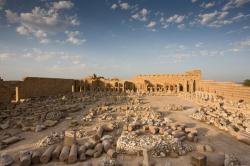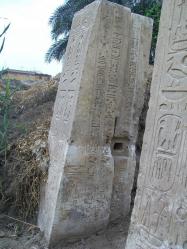INSTITUT SUPERIEUR D'ANTHROPOLOGIE
INSTITUTE OF ANTHROPOLOGY
ONLINE COURSES / COURS A DISTANCE
SUMMER TERM : JULY 2013
REGISTER NOW
LIBYE – 
 Leptis Magna - Once an important city of the Roman empire, Leptis Magna in modern day Libya stands today as one of the world’s best preserved archaeological sites. Still, despite rivalling the Carthage and Palmyra in terms of size and scope, it remained largely unknown to the general public. During the revolution that toppled the late Libyan leader Muammar Gaddafi the world had the opportunity to hear more about Leptis Magna, which finally made headlines as an endangered cultural heritage site. Last summer, in the wake of the Libyan revolution, the French archaeological mission for Libya, led by Vincent Michel, returned to the site. As one of the most important archeological studies taking place in Leptis Magna, Michel’s mission focuses on excavating the Roman baths. Once the study is completed, Leptis Magna will become a reference for the late Antique period of Libya. Still, a lack of conservation measures has led archaeologists to worry about the impact of tourism and vandalism, while the country’s ongoing turmoil and a recent attack on the French embassy are threatening to put a premature end to their research. What the future holds, it is unknown. What is true is that Leptis Magna has to be studied and protected for the good of future generations.
Leptis Magna - Once an important city of the Roman empire, Leptis Magna in modern day Libya stands today as one of the world’s best preserved archaeological sites. Still, despite rivalling the Carthage and Palmyra in terms of size and scope, it remained largely unknown to the general public. During the revolution that toppled the late Libyan leader Muammar Gaddafi the world had the opportunity to hear more about Leptis Magna, which finally made headlines as an endangered cultural heritage site. Last summer, in the wake of the Libyan revolution, the French archaeological mission for Libya, led by Vincent Michel, returned to the site. As one of the most important archeological studies taking place in Leptis Magna, Michel’s mission focuses on excavating the Roman baths. Once the study is completed, Leptis Magna will become a reference for the late Antique period of Libya. Still, a lack of conservation measures has led archaeologists to worry about the impact of tourism and vandalism, while the country’s ongoing turmoil and a recent attack on the French embassy are threatening to put a premature end to their research. What the future holds, it is unknown. What is true is that Leptis Magna has to be studied and protected for the good of future generations.
http://www.archaiologia.gr/en/blog/2013/06/27/resuming-work-in-leptis-magna/
ROYAUME UNI –  Edinburgh - The remains of a Georgian harbour and old potteries in Edinburgh have been uncovered in an archaeological dig. The site in Portobello is being excavated and recorded ahead of the development of the former funfair. The harbour wall was built in 1787 to serve the pottery industry at Portobello. From 1765, pottery became an important industry in the area, with the last pottery closing in 1972. The excavations have uncovered the wall of the harbour along with significant quantities of 19th century pottery, the earliest dated around 1810.
Edinburgh - The remains of a Georgian harbour and old potteries in Edinburgh have been uncovered in an archaeological dig. The site in Portobello is being excavated and recorded ahead of the development of the former funfair. The harbour wall was built in 1787 to serve the pottery industry at Portobello. From 1765, pottery became an important industry in the area, with the last pottery closing in 1972. The excavations have uncovered the wall of the harbour along with significant quantities of 19th century pottery, the earliest dated around 1810.
VIDEO = http://local.stv.tv/edinburgh/230960-remains-of-georgian-harbour-and-old-potteries-uncovered-in-portobello/
EGYPTE –  Heliopolis - The Gate of Ramsis IX of the Ramesside Temple of Ra in Arab Al-Hisn in Ancient Heliopolis, Cairo was set ablaze in the early hours of Wednesday. Archaeologist Monica Hanna said as a result of the fire, “the inscriptions are in very bad condition.” She believes that “thugs” are behind the fire, ones who wish to seize the land on which the ancient temple lies, calling this part of a “systematic campaign.”
Heliopolis - The Gate of Ramsis IX of the Ramesside Temple of Ra in Arab Al-Hisn in Ancient Heliopolis, Cairo was set ablaze in the early hours of Wednesday. Archaeologist Monica Hanna said as a result of the fire, “the inscriptions are in very bad condition.” She believes that “thugs” are behind the fire, ones who wish to seize the land on which the ancient temple lies, calling this part of a “systematic campaign.”
http://www.dailynewsegypt.com/2013/06/26/fire-scorches-ancient-temple-gate/#dnePhoto/0/
TURQUIE –  Akdamar - The restoration works at the Akdamar Church on Van Lake’s Akdamar Island, which has become a monument museum, have started. Structures like the monastery and chapel, which were unearthed during archaeological excavations and supported by sacks filled with rottenstones to prevent destruction, will be restored in six months using hydraulic lime to be brought from Italy. Akdamar Island will also be outfitted with 24-hour security cameras. The first restoration of the church was initiated in May 2005 and ended in July 2006. The church was opened as the Monument Museum on March 29, 2007. The cost of the restoration was 4 million Turkish Liras. Armenians were given permission to worship once a year in the church and the first worship ceremony took place on Sept. 19, 2010. With the technical team, a total of 50 people will work on the restoration and materials will be carried to the island by boat.
Akdamar - The restoration works at the Akdamar Church on Van Lake’s Akdamar Island, which has become a monument museum, have started. Structures like the monastery and chapel, which were unearthed during archaeological excavations and supported by sacks filled with rottenstones to prevent destruction, will be restored in six months using hydraulic lime to be brought from Italy. Akdamar Island will also be outfitted with 24-hour security cameras. The first restoration of the church was initiated in May 2005 and ended in July 2006. The church was opened as the Monument Museum on March 29, 2007. The cost of the restoration was 4 million Turkish Liras. Armenians were given permission to worship once a year in the church and the first worship ceremony took place on Sept. 19, 2010. With the technical team, a total of 50 people will work on the restoration and materials will be carried to the island by boat.
http://www.hurriyetdailynews.com/restorations-continue-at-akdamar-church.aspx?pageID=238&nID=49507&NewsCatID=375
GRECE – Stromi - A tomb of the Early Roman period was excavated at the foot of the hill Tsouka, near the Stromi settlement of the municipal unit Kallieis. The excavation was carried out by a team of the 10th Ephorate of Prehistorc and Classical Antiquities. It lasted three days and was headed by Director of the Ephorate, archaeologist Athanasia Psalti. It should be noted that the archaeological interest about the area was already known by the beginning of the 20th century, and the scientific community was informed about the existence of antiquities at the Tsouka hill, though no excavation had been conducted there in the past. It is an underground chamber tomb. Its side walls were made of porous stone of irregular shape. The tomb was located on 1,000 m height, at a site covered by a fir and oak forest. Despite the fact that the burial site had been disturbed, the preliminary study of the finds and the skeletal remains leads to the conclusion that the site had been used for at least three burials between the 1st century BC and the 1st century AD. During the field survey, the cover of a stone sarcophagus was found at a small distance. The cover had a relief Gorgon’s head with an inscription, dated to the Roman period. The burial goods, an abundance of clay pottery (pithoi, plates, unguent vessels, cooking pots, lamps, two bronze coins and iron strigils), offer valuable information about the archaeological past of the region and shed light to previously unknown aspects of its history. Furthermore, these finds show that an archaeological investigation of the whole area of the Tsouka hill, were remains of an ancient fortification are preserved, is imperative. The finds of the Tsouka tomb have already been moved to the conservation workshop of the Archaeological Museum of Delphi. Special scientists have been asked to investigate the skeletal remains.
http://www.archaiologia.gr/en/blog/2013/06/26/early-roman-tomb-excavated-in-stromi/
ROYAUME UNI – Conwi - The remains of a medieval house and cesspit that could date back to the time of the 13th Century Conwy Castle have been uncovered by workmen. The remains of a road and other artefacts have also been found in Castle Street about 100 metres from the castle itself. Ashley Batten, senior planning archaeologist with the Gwynedd Archaeological Planning Service, said the remains could date from before the revolt against English forces, when it is thought that the entire town was burnt to the ground about 1401. The earliest upstanding domestic building within the town walls is the National Trust run Ty Aberconwy which is dated between 1417-20. The latest find is "incredibly important," Mr Batten said. "The key thing is the remains are deeply stratified remains. There are lots of layers of activity as you would expect in an urban area. He added a "medieval cross section" of what was hidden under the ground had been uncovered by a trench dug by the workmen installing a sewage pipe. Also found were items of medieval glazed pottery, coins and metalwork which will give details about medieval Conwy once they have been researched in post-excavation work, he said. "It gives us an insight into medieval Conwy which may predate the Glyndwr revolts." In a statement Dwr Cymru Welsh Water said: "During the course of our work on Castle Street, we have found items and features of archaeological interest. These have included remains of a medieval road, coins and pieces of pottery.
http://www.bbc.co.uk/news/uk-wales-north-west-wales-23056162
FRANCE – Vaucelles - L'Institut national de recherches archéologiques préventives (Inrap) mène actuellement une fouille sur la commune de Vaucelles, à proximité de Bayeux. Il présentait ce jeudi matin ses découvertes. Dans le cadre de fouilles préventives avant l'installation d'un éco-quartier, l'Inrap a encore mis au jour de nombreuses pièces archéologiques. Des vestiges de l’époque néolithique et des âges des Métaux (âges du Bronze et du Fer) ont été déterrés : ils permettront de mieux connaître ce site, vieux de plus de 5 000 ans.
http://www.tendanceouest.com/caen/depeche-56714-nouvelles-decouvertes-archeologiques-a-vaucelles-.html?version=saintlo